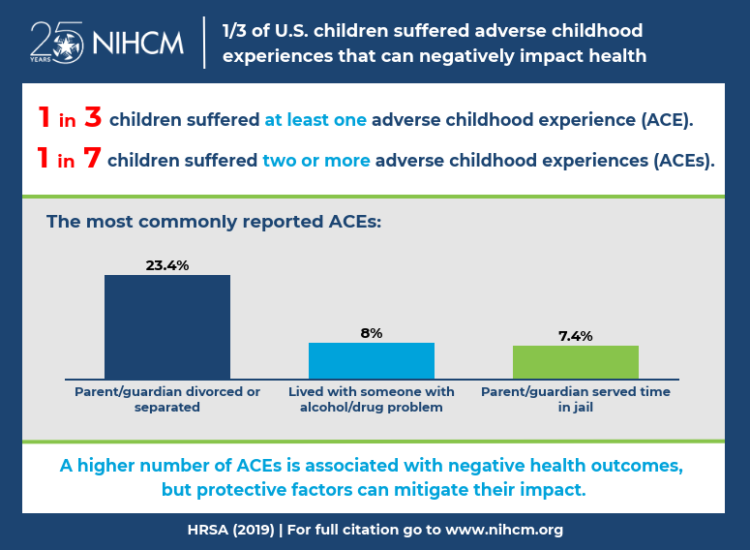NIHCM Newsletter / November 2019
How Adverse Childhood Experiences Impact Health

Adverse childhood experiences (ACEs) are defined by the Centers for Disease Control and Prevention (CDC) as potentially traumatic events that occur in childhood. A landmark study found that the risk of negative health outcomes increases for each ACE a person has suffered.
Last month, the Health Resources and Services Administration released new data on children's health, finding that one in three children have experienced at least one ACE, and 14% experienced two or more. The most common ACEs were having a parent/guardian divorced or separated; living with someone with an alcohol or drug problem; and having a parent/guardian who has served time in jail. Protective factors can mitigate the impact of ACEs, so this data can help guide interventions to prevent poor outcomes.
Closing the Gaps in Access to Stable, Affordable Housing
In our recent briefing on the social determinants of health, a common theme from all of our speakers was the importance of stable housing for the health and well-being of both communities and individuals. Yet according to the Joint Center for Housing Studies, homelessness is on the rise in some states, and 22.5% of homeowners are cost-burdened (meaning they pay 30% of their income or more on housing). Organizations from both the public and private sector are working to help close these gaps in access to affordable housing:
- The U.S. Department of Housing and Urban Development has awarded $42.8 million in housing counseling grants across the country to help people keep their homes and avoid foreclosure.
- In Detroit - where 39,000 people were displaced from their homes in recent years by foreclosure - Blue Cross Blue Shield of Michigan is investing $5 million in the city to expand and preserve affordable housing, improve streetscapes and walkability and support local business development.

Health in Rural America: Innovative Solutions to Address Disparities
Join us on November 13th for a webinar exploring the complex rural health crisis facing America.
Increasing urbanization is leaving behind an older, sicker, and poorer population in rural America that may struggle with social determinants of health like access to medical care and healthy meals. These challenges contribute to rural-urban health inequities in rates of chronic conditions like obesity and diabetes.
We'll explore how leaders are defying the odds and leveraging the unique strengths of rural communities to develop and implement promising solutions.
Improving Access to Care to Advance Health Equity
Health inequities can be exacerbated by barriers like lack of health care coverage and lack of access to health care providers. To improve health care coverage, the Blue Cross and Blue Shield of Minnesota Foundation awarded more than $1.4 million in grants to 12 nonprofits in the state, primarily to support outreach navigators to help enroll uninsured community members into a plan. To improve access to providers, Arkansas Blue Cross and Blue Shield is partnering with the University of Arkansas for Medical Sciences to advance digital health in the state, particularly in rural areas.
The Movement to Bring the Mouth Back Into the Body
Though oral health has historically been segregated from the rest of physical health, some organizations are working to "bring the mouth back into the body" and improve access to dental care. Gum disease affects chronic conditions like diabetes, heart disease and stroke, and pregnant women with gum disease may be at increased risk of premature birth and low birth weight. In the Carolinas, the Duke Endowment, the Blue Cross and Blue Shield of North Carolina Foundation and the BlueCross BlueShield of South Carolina Foundation are investing $35 million over five years to improve access to dental care through school-based oral health programs and partnerships to integrate dental care with medical care.
Have You Gotten Your Flu Shot?
A deadly flu in Australia is driving concerns that this year's flu season in the U.S. will be rough. Getting a flu shot provides protection against several strains of the flu, lowers the risk of hospitalization and death, and helps to prevent the spread of the disease to those who can't be vaccinated. Pregnant women are encouraged to get both a flu shot and the vaccine for whooping cough to protect themselves and to pass on immunity to their babies.
More Related Articles
See More on: Maternal and Child Health | Social Determinants of Health
